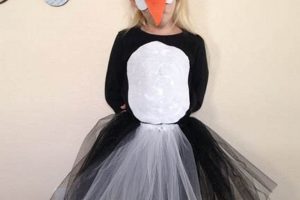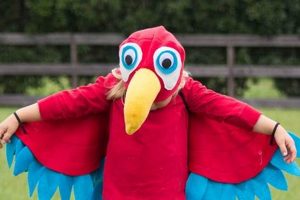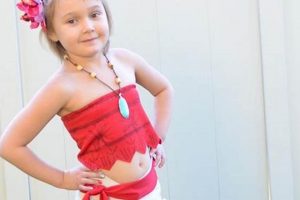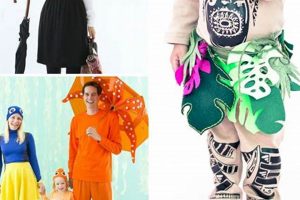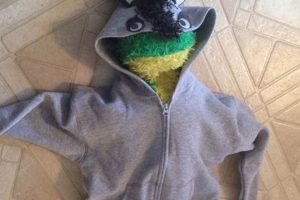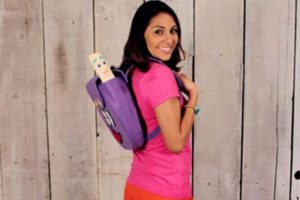An “Oompa Loompa” recreation, achieved through do-it-yourself methods, involves the construction of attire emulating the appearance of the fictional characters from Roald Dahl’s “Charlie and the Chocolate Factory.” This typically necessitates assembling elements such as brown and white striped shirts, white overalls, striped socks, and potentially orange face paint or alternative skin-tone makeup. The end goal is a visual representation of the distinct Oompa Loompa aesthetic, constructed from readily available or repurposed materials.
Creative fabrication of character-inspired clothing offers numerous advantages. It provides a cost-effective alternative to purchasing pre-made costumes. The process also fosters creativity and allows for personalization, enabling individuals to tailor the resulting garment to their specific preferences and body type. Historically, individuals have engaged in such activities for theatrical productions, themed parties, and Halloween celebrations, with a growing trend toward resourceful and environmentally conscious crafting practices.
The subsequent discussion will delve into the key components of crafting such a representation, outlining material choices, construction techniques, and potential variations that can be employed to achieve the desired outcome. The article will also address safety considerations related to makeup and material selection, ensuring a responsible and enjoyable crafting experience.
Oompa Loompa Character Recreation
The following guidelines provide practical advice for constructing attire representative of the Oompa Loompa characters, focusing on accuracy, safety, and resourcefulness.
Tip 1: Skin Tone Attainment. Achieve the characteristic skin tone through careful makeup selection. Opt for water-based, hypoallergenic orange face paint or body paint to minimize skin irritation. Conduct a patch test on a small area of skin 24 hours prior to full application to identify potential allergic reactions.
Tip 2: Wig Selection and Styling. Choose a vibrant green wig of appropriate length and style. Consider a pre-styled wig for convenience or purchase a basic wig and utilize hairspray and styling techniques to achieve the desired voluminous and slightly unkempt Oompa Loompa hairstyle.
Tip 3: Overalls Construction. Utilize white denim or cotton fabric for the overalls. Employ a basic overalls pattern or adapt an existing pattern to ensure proper fit. Reinforce seams and stress points for durability. Consider adding functional pockets for practicality.
Tip 4: Striped Shirt Fabrication. Construct the striped shirt from brown and white striped knit fabric. Ensure the stripes are horizontally aligned and evenly spaced. A simple t-shirt pattern can be adapted for this purpose. Consider the breathability of the fabric for comfort during extended wear.
Tip 5: Sock and Shoe Selection. Pair the costume with horizontally striped socks, preferably in a coordinating color scheme (brown and white, or orange and white). Select brown or black shoes that are comfortable for walking and standing. Consider adding spats or gaiters for a more authentic appearance.
Tip 6: Material Sourcing. Prioritize cost-effective material procurement. Explore thrift stores, fabric remnants sales, and online marketplaces for discounted fabrics and accessories. Repurposing existing clothing items can further reduce costs and promote sustainability.
Tip 7: Safety Precautions. Exercise caution when using sharp tools such as scissors and sewing needles. Ensure adequate ventilation when applying face paint or hairspray. Avoid wearing the costume in situations where visibility is impaired or where it poses a tripping hazard.
Adherence to these guidelines will facilitate the creation of a visually accurate and safe representation of the fictional Oompa Loompa characters. Careful planning and attention to detail are essential for achieving a successful outcome.
The subsequent sections will explore specific material recommendations and advanced construction techniques for further refining the overall quality and authenticity of the costume.
1. Orange skin tone
The accurate depiction of the orange skin tone is a critical component in the successful execution of a do-it-yourself Oompa Loompa representation. The visual recognition of the character is intrinsically linked to this distinctive characteristic, requiring careful consideration and execution.
- Makeup Selection
The choice of makeup is paramount. Water-based, hypoallergenic face and body paints are recommended to minimize adverse skin reactions. Oil-based paints, while potentially offering greater color saturation, often pose a higher risk of irritation and are generally discouraged. The specific shade of orange should be carefully considered, avoiding tones that appear overly artificial or unnatural. Furthermore, the application technique must ensure even coverage and avoid streaking or patchiness, which can detract from the overall effect.
- Application Technique
Even distribution of the chosen color is essential. This requires the use of appropriate tools, such as makeup sponges or brushes, and a layering approach. Multiple thin coats are preferable to a single thick layer, reducing the likelihood of cracking or creasing. Blending at the edges is also crucial to avoid harsh lines and create a more seamless transition between the painted and unpainted skin. Consider using a makeup sealant to prolong the wear time and prevent transfer onto clothing.
- Safety Considerations
Prioritize safety when selecting and applying makeup. Always perform a patch test on a small area of skin 24 hours prior to full application to identify potential allergic reactions. Avoid applying makeup to broken or irritated skin. Ensure proper ventilation during application to minimize inhalation of fumes. Remove makeup thoroughly after use with a gentle cleanser to prevent pore clogging and skin irritation. Be aware of potential staining of clothing or surfaces and take appropriate precautions.
- Alternatives to Makeup
While makeup is the most common method for achieving the orange skin tone, alternative approaches may be considered. These include the use of full-body suits or bodysuits made from orange fabric. However, these options may present challenges in terms of breathability and comfort, particularly in warmer environments. The selection of fabric should prioritize comfort and non-toxicity. These alternatives offer a way to circumvent potential skin sensitivities to makeup, but require careful planning and execution to achieve a believable and aesthetically pleasing result.
The accurate and safe attainment of the orange skin tone is fundamental to the creation of a credible Oompa Loompa impression. Meticulous attention to makeup selection, application technique, safety considerations, and potential alternatives contributes significantly to the overall effectiveness of the constructed representation.
2. Green wig required
h3>
The presence of a green wig constitutes a defining characteristic in the endeavor of creating a do-it-yourself Oompa Loompa representation. Its visual prominence immediately signifies the connection to the fictional characters from “Charlie and the Chocolate Factory,” making it a crucial element for recognizable and effective attire.
- Color Accuracy
The shade of green significantly impacts the overall authenticity. A vibrant, almost artificial green is most congruent with the established visual portrayal. Subdued or natural shades of green diminish the intended effect. Consideration should be given to matching the wig’s hue to other costume components, such as makeup, to create a cohesive aesthetic.
- Style and Volume
The Oompa Loompa hairstyle typically involves significant volume and a slightly unkempt appearance. Wigs should be styled to reflect this characteristic. Backcombing, teasing, and the strategic application of hairspray can contribute to achieving the desired silhouette. Pre-styled wigs specifically designed for Oompa Loompa recreations offer a convenient alternative.
- Wig Material and Quality
The material composition influences the wig’s appearance and manageability. Synthetic fibers are commonly employed due to their affordability and ease of styling. Higher-quality synthetic wigs often exhibit a more realistic texture and are less prone to tangling. Human hair wigs, while more expensive, offer the most natural appearance and styling versatility, though they may require more maintenance.
- Attachment and Security
Secure attachment of the wig is paramount for maintaining the integrity of the costume. Wig caps are recommended to provide a smooth surface and prevent slippage. Wig combs or clips can further enhance security, particularly during activities involving movement or dancing. Proper wig placement ensures a natural hairline and avoids exposing the wearer’s natural hair.
The selection, styling, and secure attachment of a green wig directly influence the visual impact of any Oompa Loompa recreation. By paying attention to the elements of color accuracy, style, material composition, and attachment methods, one increases the probability of an outcome that effectively embodies the character’s distinguishing traits.
3. Striped shirt design
The striped shirt design is a fundamental element in the creation of a do-it-yourself Oompa Loompa representation. It serves as an immediately recognizable marker, instantly associating the wearer with the fictional characters. The absence of accurate stripes diminishes the effectiveness of the entire costume, as it disrupts the established visual schema. For example, a plain shirt, regardless of color, will not convey the intended character, thereby failing to achieve the costume’s purpose. The specific attributes of the stripes, including color, width, and orientation, directly influence the overall impression. Achieving the correct striped shirt design is not merely aesthetic; it is integral to the successful conveyance of the intended identity.
The practical implications of understanding the significance of the striped shirt design extend to the construction phase. The selection of fabric, the method of creating the stripes (sewing separate pieces, painting, or using pre-striped material), and the shirt’s overall fit must all be considered in relation to the established visual expectations. If the stripes are too wide, the shirt appears clownish; if they are too narrow, the overall effect is diluted. Furthermore, the choice of fabric impacts comfort and durability. A poorly constructed shirt, regardless of accurate stripes, detracts from the overall presentatio. Examples of successful Oompa Loompa representations invariably feature a well-executed striped shirt design, demonstrating the impact of this component.
In summary, the striped shirt design is not a peripheral detail but a central component of the Oompa Loompa. Attending carefully to its construction is essential for achieving the desired visual effect. Deviations from established visual expectations diminish the costumes overall impact. Practical application hinges upon the selection of appropriate materials and construction techniques, directly linking the theoretical understanding of its importance to the practical realization of a convincing Oompa Loompa character.
4. White overalls needed
The presence of white overalls is a non-negotiable element in a do-it-yourself Oompa Loompa costume. This clothing item serves as a key visual identifier. Replacing it with any other garment style, regardless of color, instantly compromises the costume’s recognizability. The overalls are not merely a stylistic choice; they are a fundamental component deeply embedded within the collective perception of the character. For instance, substituting the overalls with pants or a skirt, even in white, fails to evoke the desired image.
The practical significance of this understanding manifests during the costume construction process. Recognizing the centrality of the overalls dictates that substantial effort is directed toward sourcing or creating an appropriate garment. This might involve repurposing existing white overalls, modifying existing garments to resemble overalls, or constructing overalls from raw materials. The construction process involves careful consideration of fabric selection, pattern creation, and sewing techniques to ensure the finished product accurately reflects the established visual characteristics. The decision to omit or misrepresent the overalls constitutes a critical design flaw, undermining the entire endeavor.
In summation, the white overalls are inextricably linked to the visual identity of the Oompa Loompa character. Their inclusion is not optional; it is essential. A successful costume hinges upon acknowledging and addressing this requirement, dedicating the necessary resources and effort to create an accurate and convincing representation. Failure to do so results in a costume that, regardless of other details, fails to capture the essence of the intended character.
5. Sock color details
Sock color details, while seemingly minor, contribute significantly to the overall success of a do-it-yourself Oompa Loompa representation. The selection of sock color directly influences the visual cohesion and perceived authenticity of the costume. Inaccurate sock colors detract from the established visual schema, creating a discordant element that diminishes the impact of the entire ensemble. For example, incorporating socks that clash with the color palette of the shirt or makeup creates an unintended distraction, undermining the intended character representation.
The practical application of this understanding translates to a conscious decision-making process during the costume creation phase. Careful consideration is given to the established
color scheme of the Oompa Loompa characters, typically involving stripes or solid colors that complement the overall aesthetic. Sourcing socks in appropriate colors or modifying existing socks to achieve the desired effect becomes a necessary step. Examples include painting or dyeing plain socks to match the costume’s color palette or seeking out striped socks in the appropriate color combinations. Failure to address the details of sock color results in a subtle, yet perceptible, disruption of the visual harmony, lessening the overall effectiveness of the endeavor.
In conclusion, sock color details are an integral, albeit often overlooked, aspect of an effective Oompa Loompa recreation. The correct color choice enhances visual coherence. Addressing sock color details contributes to the overall visual success. Therefore, neglecting this element leads to a less compelling and credible representation of the intended character. Prioritizing attention to sock color is essential for a satisfactory outcome.
6. Safe makeup usage
The creation of a “diy oompa loompa costume” frequently involves the application of significant quantities of makeup, particularly orange face and body paint, to emulate the characters’ distinct complexion. This necessity underscores the critical importance of safe makeup usage. The extensive application of makeup, especially over large surface areas, increases the potential for adverse skin reactions, including allergic dermatitis, irritation, and pore clogging. Consequently, prioritizing the selection of hypoallergenic, non-comedogenic products becomes paramount. For instance, the use of theatrical-grade makeup, while often providing vibrant colors, may contain harsh chemicals that are unsuitable for prolonged skin contact. A real-life example would be a child developing a severe rash after wearing a low-quality orange face paint for several hours at a costume party. Therefore, the choice of makeup must be deliberate and informed, emphasizing safety over aesthetic considerations alone.
Practical application of safe makeup usage principles involves several key steps. First, a patch test should be conducted at least 24 hours prior to full application. This entails applying a small amount of the chosen makeup to a discreet area of skin, such as the inner forearm, and observing for any signs of irritation. Second, the application process should be carried out using clean applicators, such as disposable sponges or brushes, to minimize the risk of bacterial contamination. Third, makeup should be removed thoroughly after use with a gentle cleanser to prevent pore clogging and subsequent breakouts. Fourth, individuals with pre-existing skin conditions, such as eczema or psoriasis, should consult with a dermatologist before applying any makeup. Ignoring these precautions can lead to significant discomfort and potentially long-term skin damage.
In summary, safe makeup usage is not merely a peripheral concern but an integral component of any “diy oompa loompa costume” endeavor. The potential for adverse skin reactions necessitates a proactive approach, prioritizing the selection of appropriate products, meticulous application techniques, and thorough removal procedures. Challenges may arise in balancing aesthetic desires with safety considerations, requiring informed decision-making and a willingness to compromise on color vibrancy or product availability in favor of skin health. By adhering to these principles, individuals can create an effective costume while minimizing the risk of harm.
7. Cost-effective materials
The creation of a do-it-yourself Oompa Loompa representation necessitates a pragmatic approach to material selection, dictated, in part, by the goal of minimizing expenditure. The financial accessibility of the constituent components directly impacts the feasibility and widespread adoption of this creative endeavor.
- Thrift Store Sourcing
Thrift stores serve as repositories of discarded clothing and textiles, often providing suitable base materials for costume construction at significantly reduced prices. Examples include white denim for overalls, brown and white striped shirts (or materials to create them), and green fabric suitable for wig creation. The implications include potential savings of up to 75% compared to purchasing new materials, although this advantage necessitates time investment in searching and potential alterations to pre-existing garments.
- Fabric Remnant Utilization
Fabric stores frequently offer remnant sections containing smaller pieces of fabric left over from larger cuts. These remnants, often available at discounted rates, can be sufficient for constructing smaller costume elements, such as socks, patches, or wig components. Real-world examples include obtaining sufficient striped fabric for sleeves or sock tops at a fraction of the cost of purchasing a full yard. The impact involves resourcefulness in utilizing smaller quantities of material, requiring creative planning to maximize available resources.
- Repurposed Household Items
Household items can be creatively repurposed to reduce material costs. Examples include using old towels or felt scraps for wig padding, plastic bottles for creating structural elements within the overalls, or cardboard for reinforcing shoe covers. The benefit lies in diverting materials from the waste stream, contributing to environmental sustainability while simultaneously reducing financial outlay. However, this approach requires ingenuity and adaptability in finding alternative uses for common items.
- Discount Retailers and Online Marketplaces
Discount retailers and online marketplaces offer affordable alternatives to specialty fabric stores. Sourcing basic materials, such as plain white fabric for overalls or inexpensive orange face paint, can be achieved at significantly reduced prices. Examples include purchasing plain white t-shirts and altering them into overalls or acquiring bulk quantities of inexpensive makeup. The implications involve balancing cost savings with potential compromises in material quality, requiring careful evaluation of product reviews and material specifications.
The strategic utilization of cost-effective materials is paramount in the successful execution of a do-it-yourself Oompa Loompa character representation. The combination of thrift store sourcing, remnant utilization, repurposed items, and discounted retailers enables the creation of visually compelling costumes without incurring excessive financial burden. The selection and application of these approaches require both resourcefulness and adaptability, ensuring an effective outcome is achieved within budgetary constraints.
Frequently Asked Questions
This section addresses common inquiries regarding the creation of a do-it-yourself Oompa Loompa costume, offering insights into construction techniques, material selection, and safety considerations.
Question 1: Is it possible to achieve a convincing Oompa Loompa aesthetic without using orange face paint?
Alternative approaches exist. Orange-toned bodysuits or full-body suits constructed from stretch fabric offer a viable alternative. These options circumvent potential skin sensitivities associated with makeup application, although considerations must be given to breathability and comfort.
Question
2: What fabric is most suitable for constructing Oompa Loompa overalls?
Durable and easily washable fabrics are recommended. White denim, canvas, or heavy cotton twill represent appropriate choices. The selection should balance durability, comfort, and ease of manipulation during the sewing process.
Question 3: How can the characteristic Oompa Loompa hairstyle be achieved without purchasing a pre-styled wig?
A basic green wig can be styled to resemble the Oompa Loompa hairstyle. Techniques such as backcombing, teasing, and the application of hairspray can increase volume and create the desired unkempt appearance. Tutorials are available online demonstrating specific styling methods.
Question 4: What are the primary safety concerns associated with wearing an Oompa Loompa costume?
Potential hazards include impaired visibility due to the wig, skin irritation from makeup, and tripping hazards from oversized shoes or poorly fitted garments. Precautions include ensuring clear peripheral vision, using hypoallergenic makeup, and selecting footwear that provides adequate stability.
Question 5: How can the cost of creating an Oompa Loompa costume be minimized?
Cost-effective strategies include sourcing materials from thrift stores, utilizing fabric remnants, repurposing existing clothing items, and purchasing discounted materials from online marketplaces. Creative resourcefulness is essential for minimizing expenditure.
Question 6: What are the essential elements that contribute to a recognizable and effective Oompa Loompa costume?
Key components include accurate skin tone representation, a vibrant green wig with appropriate styling, a brown and white striped shirt, white overalls, and complementary socks. Attention to detail and adherence to established visual cues are crucial for achieving a successful outcome.
The information provided addresses fundamental considerations for constructing a do-it-yourself Oompa Loompa costume. Prior planning and attention to safety are crucial.
The subsequent section will present additional resources and examples of successful Oompa Loompa costumes.
Conclusion
This exploration of the “diy oompa loompa costume” has outlined critical elements for a successful recreation. Accurate skin tone, a vibrant green wig, precisely designed striped shirt, proper overall construction, and carefully considered sock color all contribute significantly to the overall visual impact. Furthermore, the application of safe makeup practices and the strategic utilization of cost-effective materials are paramount for both well-being and budgetary constraints.
Ultimately, the creation of a compelling Oompa Loompa representation necessitates a balance between adherence to established visual norms, creative resourcefulness, and practical considerations for safety and affordability. The effective embodiment of the character depends not only on the acquisition of materials but on careful planning, attention to detail, and a commitment to both visual accuracy and responsible construction techniques. The endeavor represents a synthesis of artistic expression and practical skill, culminating in a tangible representation of a beloved fictional icon.


